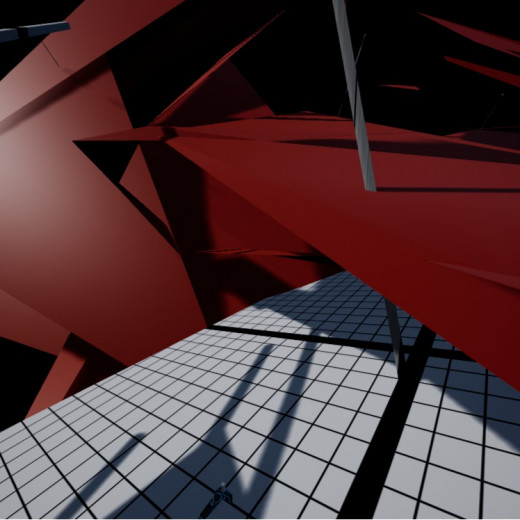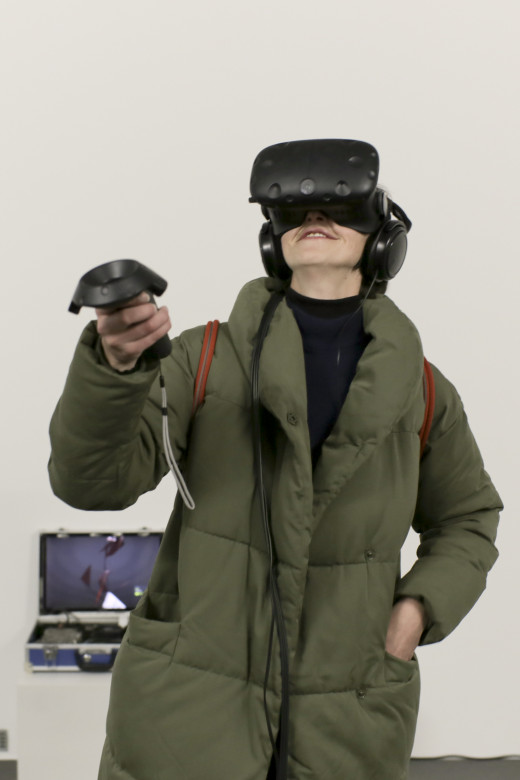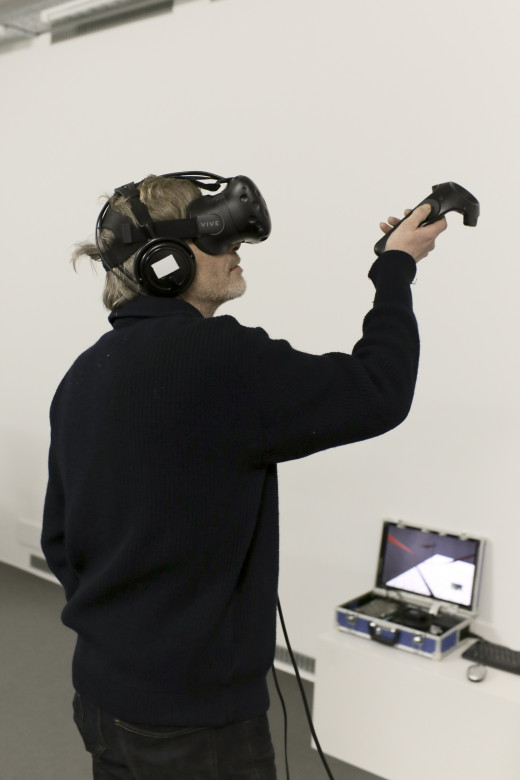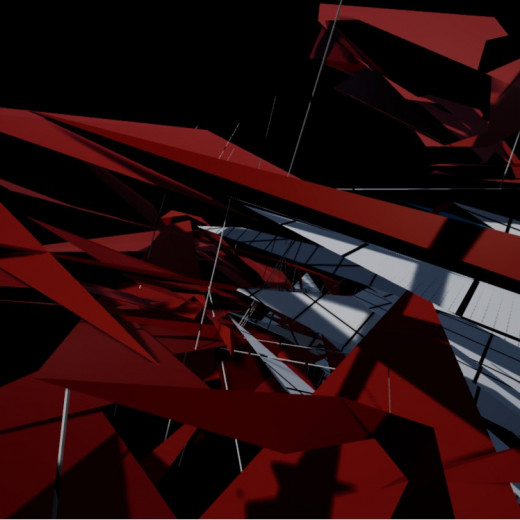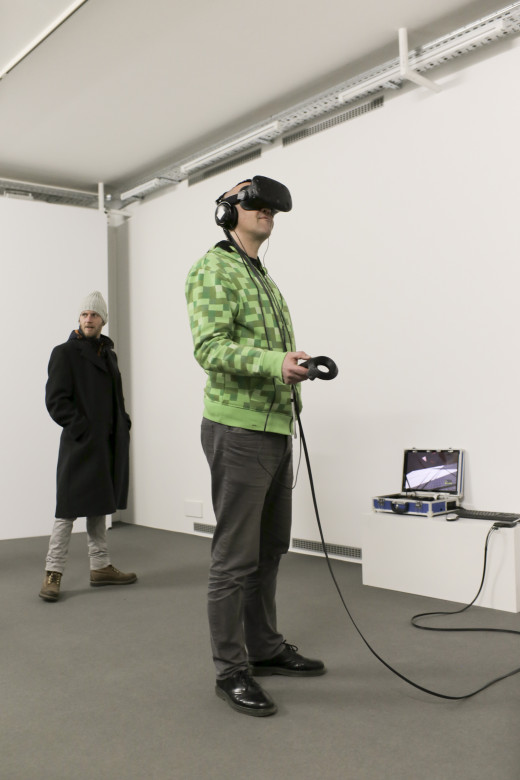Description
The installation places the viewer in an environment in which the form of the observed is directly related to the way it is observed and to the viewers movement in the virtual space. The viewer finds himself in a sort of feedback loop where things that catch his attention inevitably become the seed for new things which can catch his interest. He is therefore not a passive observer but also the creator of what he is looking at. In a way he is also being observed by the installation with which he is in a simbiotic relationship.
“In evaluating systems the artist is a perspectivist considering goals, boundaries, structure, input, output, and related activity inside and outside the system. Where the object almost always has a fixed shape and boundaries, the consistency of a system may be altered in time and space, its behavior determined both by external conditions and its mechanisms of control.”
— Jack Burnham: Systems Esthetics [1]The exhibition space in PD4 is empty. There are only a pair of VR goggles [2] and a couple of transmitters. The artwork is not present in three-dimensional space. Its object is a virtual body that extends into the algorithmic infinity of alternate reality.
PD4 explores the idea of presence and self-awareness measured by effects such as a sense of space, time, the body and emotional states. It also deals with the idea of (un)real spaces. The visitor becomes a player in a reality game in which one is constantly losing one’s sense of one’s own body and, therefore, feeling the gravity of one’s own corporeality even more. By creating monochromatic autogenerative levitational architectural elements, the artist conceives a programmed space that the player produces with his or her gaze. He is interested in improvisational aesthetics and the metamorphoses of a live computed sculpture in which the morphing space becomes the spectator’s psychological portrait. Active players are struggling with a sense of balance and orientation in the unpredictable, constantly growing space. Passive spectators are overwhelmed by the expanding constructions, feeling immersed in a doubly interior space: firstly in the space within virtual architecture, and secondly in the space within their own perceptual apparatuses. What the spectator is viewing is not a digital image, but rather a very corporeal image. The architecture of space is not something external, but rather an intrinsic string of characteristics that grow at various levels of syntax and manifest themselves as a set of random formations. These discreet sequences are translated in space as continuous events. The entire environment in PD4 is a sensitive alternate body composed of data-points that deconstruct or saturate.
The space of the alternate reality of PD4 is programmed with Unreal Engine 4, a suite of integrated tools for professional developers of games, simulations and visualisations. [3] Simulations of commercial virtual spaces, which, among others, use these tools, are inclined to producing approximations of reality, whereas Čadež is interested in exploring the boundaries of algorithmic worlds. He is interested in physical and mental effects escaping the users’ control. The aesthetics of PD4 does not aim at effects that would be “better than reality”. In PD4, the player does not identify with anything. PD4 is a simulacrum, it is a walk through alternate nature, the incoherent world with a new geography testing the limits of its own perception. The player is dealing with one’s own corporeality, depth, height, searching for a point of orientation, which challenges all established or learned perceptual processes. The game has no scenario, no narrative; it has generative scenes that keep changing all the time, expanding and flipping over ad infinitum in a temporal and spatial sense. The game has no goal that could be controlled, anticipated or completed because it leads to the expansion of consciousness achieved through the medium of corporeal and mental processes. It is not an escapist resort to entertainment industry and synthetic please. If PD4 has a goal, it is to show that the greatest illusion is the idea of objective reality, the idea that there exists a world that is stable, fixed, and can be perceived as is. For we cannot prove deductively that the “real world” exists without the need for our argument to take into account our presupposition “that the real world exists”. Given the consistency of human perceptions and our seeming inability to affect the findings about these perceptions, it is reasonable to believe that a reality exists as an effect of our perception. The most we can say is that a real world exists only because we do not have sufficient evidence to prove that is does not exist.
The updated HD VR technologies with minimal lagging are announcing a new revolution in the post-information age. At last, VR consoles take into account the carbon-based body which was condemned to a passive sedentary experience for several decades. With VR technology, the player has no surrogate body or avatar that is not subject to bodily functions. Virtual environment is an apparatus for perceiving relations, which takes into account the tension between freedom and necessity. It appears as a causal network of infinite dimensions, which cannot be fully computed or foreseen, for the human body does not have a uniform or exclusively geometric sense of space that could be determined by measuring distances. Space is not uniform but rather condensed or dispersed like time and PD4 challenges our sense of both.
PD4 generates alternate reality, it is a programmed sculpture that enables the players to experience the environment that translates the architecture into a situation. PD4 produces a perceptual spectrum that is not better than real; yet, it is real in all its corporeal and mental perceptibility.
NOTES[1] Jack Burnham: Systems Esthetics, v: Artforum, New York, 1968, p. 32. See also: Jack Burnham: Systems Esthetics, in: Richard Kostelanetz, ed.: Esthetics Contemporary, Buffalo: Prometheus Books, 1978, pp. 160–171.[2] VR goggles are special glasses enabling perception of virtual reality.[3] Unreal Engine 4 tools are free for all not-for-profit users. Unreal environment is projected in VR goggles, connected to Lighthouse (HTC Vive) laser transmitters, which enable the tracking of visitors in the entire space.
Artistic Director Janez Janša
Producer Marcela Okretič
Executive Producer Sonja Grdina
Public Relations Alja Žorž
Technician Valter Udovičić
Documentation Jure Goršič (photo)
